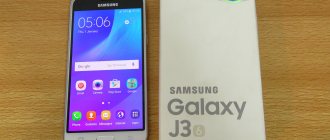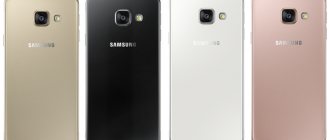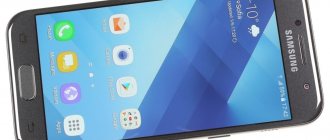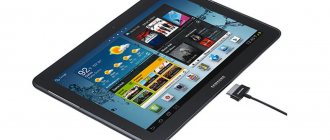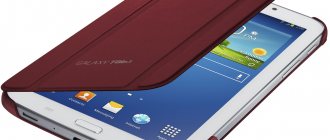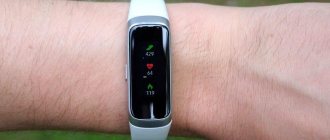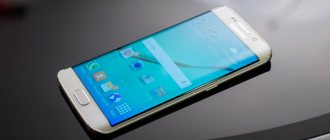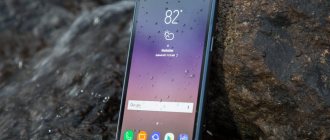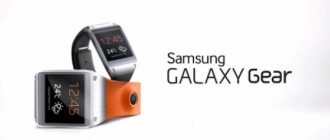Smartphone Samsung Galaxy J7 (2017) Black (SM-J730FM) - Specifications
Review
It’s impossible to immediately say which company’s equipment is the best (be it electronics, cars, etc.), it’s just that each company has successful models and not so good models (they don’t disdain options like “sell the same seeds but in a different bag” even famous brands) )) But from time to time, really worthwhile products still appear on the market, and this smartphone, in my opinion, is a successful model from Samsung. Pros: In real life it looks really more expensive than it costs and is positioned (especially in black), very high-quality assembly and materials, 2 SIM cards + 1 flash drive (no need to choose what to give up or trick something), fits perfectly in the hand (I mean in case, but what would it be like without it), the display is beyond praise, the combination of processor + video + battery of such capacity is excellent for a device of this level, the connection is confident, they can hear me well and I can hear well (this is for questions about the speakers and microphone), cameras good (especially the main one). Now a little explanation to all of the above. Since this device is positioned as a budget device, you shouldn’t expect any miracles from it (you don’t need to demand from it something for which it was not originally created), but for this reason: If you are a serious gaming addict or use some demanding 3D applications , then this device is not for you, choose something more serious, but with normal use it will definitely not disappoint you. Install the software you need, configure the device and disable everything you don’t need (fortunately, even “out of the box” Android allows you to do a lot in this regard). Web surfing, instant messengers, watching videos (especially high-quality ones in Full HD), NFC, taking photos or videos, some not too demanding games, working with the device leaves only positive impressions, and this is still with good battery life. Now about those points that I didn’t write in the “Cons” (there are no ideal things, and this smart is of course no exception, BUT...): Price - Yes, compared to competitors it looks a little expensive, and yes, Samsung apparently began to throw money on top for the name , but believe me, most likely you will stop thinking about it as soon as you pick it up and start using it))) Non-removable battery - As for me, this is rather a minus, but now this is an almost universal trend, nothing can be done about it. Flash memory - 16 gigs (of which even less is available), this is certainly not enough, but after installing everything I need, 6GB are left free, and it’s not a problem to make sure that the smart device puts applications on the card. There are also some little things (an unclear algorithm for how the proximity sensor works during a conversation, a slow response of the brightness of the ADF when taken out of a pocket, and so on), but in my opinion these are more nit-picks that are easily offset by its advantages. What I would like to recommend to those who purchased it: A good case (fortunately, the model is very popular and there are no problems with this, but the branded Samsung one is better, very high quality (except for the book)), a larger flash drive (a minute of video recording in Full HD weighs about 130MB, yes another 4-5 MB of photos, and if there are also movies on a flash drive in good resolution and quality (such rips, although they weigh 4-6 GB, look great on such a display), plus music... in total 32 GB (or rather 64 GB) for such a device This is probably a reasonable minimum (I myself use a Samsung one with 128GB, it works flawlessly.) There were a lot of letters, but if my review helped someone make the right choice, then they were not written in vain.
Review of Android smartphone Samsung Galaxy A7 (2017): a mid-segment standard?
Table of contents
- Introduction
- Specifications
- Packaging and equipment
- Appearance and design
- Display
- Hardware platform and performance
- Software and firmware
- Multimedia
- Wireless Interfaces and Communications
- File system
- Battery life
- Camera
- Comparison with competitors
- Conclusion
- Additional photos
Introduction
Many users remember how Samsung was distinguished by its tendency to produce smartphones of any price category with cases made exclusively of plastic.
At a time when other manufacturers were using premium materials with all their might, the Korean giant resisted these trends to the last. However, a few years ago, the pleas of users were heard, and the world saw the Galaxy Alpha model, which became a definite experiment of the manufacturer. The reaction to it was very positive, and in response, Samsung quickly curtailed the production of one of the most successful (in my opinion) models, launching a new Galaxy A line.
New smartphones were positioned as fashionable ones - with an emphasis on appearance and manufacturing materials, rather than performance. And with the performance of the first generation everything was sad. And the metal case, being covered with a thick layer of protective polymer, turned out to be controversial.
Fortunately, the manufacturer has somewhat reconsidered its position. Most of the new Samsung smartphones are clad in glass and metal cases, and the Galaxy A line has been improved in terms of performance and equipped with dust and moisture protection according to the IP68 standard. Today we will talk about the older version – Samsung Galaxy A7 (2017). As you might guess, the numbers in brackets reflect the model year of the device.
Moreover, this review can be considered both an introduction to the model and a small report on operating experience. The thing is that before starting general testing and writing a review, I used this smartphone as my main device for some time.
announcements and advertising
2080 Super Gigabyte Gaming OC for 60 rubles.
Compeo.ru - the right comp store without any tricks
RTX 2060 becomes cheaper before the arrival of 3xxx
Ryzen 4000
series included in computers already in Citylink
The price of MSI RTX 2070 has collapsed after the announcement of RTX 3xxx
Core i9 10 series is half the price of the same 9 series
The price of memory has been halved in Regard - it’s more expensive everywhere
Specifications Samsung Galaxy A7 (2017)
| Model | Samsung Galaxy A7 (2017) | Samsung Galaxy A7 (2016) |
| CPU | Samsung Exynos 7880, 8 x 1.9 GHz, Cortex-A53 | Samsung Exynos 7580, 8 x 1.6 GHz, Cortex-A53 |
| Video processor | Mali-T830 MP3 | Mali-T720 MP2 |
| operating system | Android 7.0 | Android 5.1.1 |
| Memory, GB | 3 RAM; 32 ROM | 3 RAM; 16 ROM |
| Screen | 5.7″ SuperAMOLED, 1920 x 1080 | 5.5″ SuperAMOLED, 1920 x 1080 |
| Cameras, Mpix | 16.0 + 16.0 | 13.0 + 5.0 |
| Net | GSM; WCDMA; LTE | GSM; WCDMA; LTE |
| Number of SIM cards, pcs. | 2 (nano-SIM) | 2 (nano-SIM) |
| MicroSD support | Yes | Yes |
| Wireless interfaces | Wi-Fi; Bluetooth; NFC | Wi-Fi; Bluetooth; NFC |
| GPS/aGPS/GLONASS | Yes Yes Yes | Yes Yes Yes |
| Battery, mAh | 3 600 | 3 300 |
| Dimensions, mm | 156.8 x 77.6 x 7.9 | 151.5 x 74.1 x 7.3 |
| Weight, g | 186 | 172 |
| price, rub. | ~25 000 / 32 990* / 27 990** | ~24 000 / 29 999* |
Retail price / *recommended price at announcement / **recommended price at time of publication.
On the one hand, the characteristics are not amazing, on the other hand, this is not a flagship device. However, there is no shortage of anything. The only thing I can complain about is the price, but perhaps the features of the new product can compensate for it?
Packaging and equipment Samsung Galaxy A7 (2017)
The hero of the review is hidden in a box consisting of a main box and a lid covering the ends. The manufacturing material was high-quality and durable cardboard. The quality of the packaging is not satisfactory; it perfectly performs its functions of protecting the contents during transportation.
The main color here is white, and the design and decoration can be described in one word - minimalism. However, this is typical for the entire line of smartphones. On the front side is the full name of the device version with clarification of the model year.
The back side is reserved for basic information about the characteristics of the device, with several features highlighted by separate icons.
Identification information for a specific item is indicated on a separate sticker on the bottom of the package. It also plays the role of a factory seal.
The device itself is supplied packed in shipping film and fixed in place in a special stand with a molded case.
The delivery kit is located in special compartments. By modern standards, he can be called rich.
In addition to the usual wired headset, we note the presence of a small adapter with which you can charge the device from a regular microUSB cable. This is a useful feature, because such an adapter is easy to keep with you, and at the moment you can find microUSB charging almost everywhere, unlike a USB Type C cable.
The Samsung Galaxy A7 (2017) package includes:
- Power adapter;
- USB Type C cable;
- microUSB – USB Type C adapter;
- Wired stereo headset;
- A key-clip for removing slots for SIM cards and memory cards.
As they say, you meet people by their clothes, so this time there’s nothing to complain about. The packaging does not seek to attract attention, but it also does not raise doubts about the safety of the contents, and this is the main thing. I was pleased with the delivery package, which offers more than the standard set of adapter and cable that comes with the vast majority of smartphones.
Design
We start the Samsung Galaxy J7 Neo 2020 review with its appearance, because this is the first thing that catches your eye. The front panel is practically no different from the manufacturer’s previous designs; it continues to follow the chosen concept. The edges of the case are rounded, which ensures comfortable use and a secure hand grip. The screen is covered by glass designed using 2.5D technology; it is rounded as it approaches the edges. It occupies about 73% of the front panel area, with thin frames on either side. The smartphone looks especially beautiful when the display is locked, then they are completely invisible and merge with the body.
Samsung Galaxy J7 review in Russian shows that a mechanical “Home” key was located under the screen, which had a built-in fingerprint scanner. On either side of it are two navigation keys, they are touch sensitive.
Above it there is a front camera, a corporate logo, a proximity and light sensor (this is already a big plus, because the 2020 model did not have it), as well as an earpiece. A pleasant surprise was the flash, with which you can take good selfies even in absolute darkness. There is no notification indicator, but instead, an equally convenient solution is used - the Always On Display option, in which the time and important events are displayed on the locked screen.
The Samsung Galaxy J7 smartphone review showed that the ends have a rounded shape, which improves the appearance and ergonomics. The bottom edge is occupied by a 3.5 mm jack, a microphone hole, plastic inserts for antennas that fit laconically into the design, and a microUSB port. The latter is upsetting, but it’s time to come to terms with the fact that Samsung is not eager to install USB-C in its budget solutions.
Each of the mechanical keys is thin and made of metal, so it is comfortable and pleasant to use. They press clearly, but do not sit perfectly in their places - they are slightly wobbly, although this can only be noticed intentionally. Perhaps we got a defective device, but it’s still unpleasant. The power control button is located on the right, and a multimedia speaker is installed just above it. In my memory, no manufacturer has ever done this, but this is a very good arrangement - it does not overlap when lying on the table or holding it in your hands in a horizontal position.
Samsung sm J710f Galaxy J7 review shows that there is nothing on the top edge, with the exception of plastic strips for antennas.
On the left are separate volume keys and trays, one of which holds a nanoSIM, and the other holds another card and microSD in addition to it. This is an ideal solution, because 16 GB of user memory will not be enough, and no one wants to give up a second SIM card.
The back panel was constructed from a single piece of metal. In its lower and upper parts there are plastic strips for placing antennas. They have an unusual shape and perfectly complement the appearance of the device. The company logo is located in the center, and at the very top is the camera and LED flash for it.
The Samsung Galaxy J7 2020 smartphone review showed that the new product looks much better than its predecessor. It is assembled from more premium materials and excellent work has been done on the ergonomics of the case. Although J is the most affordable line in the brand’s assortment, it is perceived as very expensive and prestigious.
Cameras
Samsung Galaxy J7 2020 sm j730 black review moves on to its cameras, of which there are two and both are 13 megapixels. Both the front and main modules received an LED flash. The maximum resolution for shooting video of each module is FullHD. The aperture of the main module is f/1.7, and the front camera is f/1.9. Only the main camera received autofocus.
The interface is practically no different from the standard one - on the main screen the space is occupied by a button for shutter release, video recording, selecting the flash operating mode, and also going to the settings menu. Samsung Galaxy J7 camera review in Russian showed that by swiping from right to left you can open a list of all available filters. Once you do it in the opposite direction, the choice of shooting mode will be displayed. There you can also find the HDR mode, which is inconvenient. It is much more practical when it is displayed with a separate key on the main screen, as is done by most manufacturers.
Example photo on Samsung Galaxy J7
A review of the Samsung Galaxy J7 2020 showed that the main module can take excellent pictures, provided there is high-quality lighting. With the onset of darkness, it will be more difficult to get a good shot, but it is possible. The camera beats most of its price competitors. The same applies to the front camera.
Conclusion
Compared to last year, the J series has evolved a lot. We are offered a really good gadget that is perceived as expensive and justifies the asking price. It will be of interest primarily to those who do not like Chinese manufacturers and prefer products from A-brands. Although for this price the Chinese can offer more advanced characteristics, with the exception of the camera and battery life. The smartphone is well built and looks great. The AMOLED screen is also pleasing, which also received the Always On Display option, which this year reached the budget segment for the first time. The only thing missing is the power in modern games.
Comments for the
Cackl e
You might be interested in:
Samsung Galaxy J5 - the manufacturer continues to conquer the budget market
Review of the Samsung Galaxy A5 smartphone
Samsung Galaxy J2 Prime - is it worth buying a budget phone in 2017?
Samsung Galaxy A3 2020 is a good budget phone with excellent battery life and an updated design
Samsung Galaxy J3 2020 - let's figure out what the differences are from last year's model and whether the smartphone can compete with Chinese competitors
Firmware Samsung Galaxy J7 (2016) SM-J710F
Detailed, step-by-step instructions on how to flash a Samsung Galaxy J7 (2016) SM-J710F smartphone with new official or custom firmware. Obtaining Root superuser rights on Samsung Galaxy J7 (2016) SM-J710F, installing custom recovery TWRP Recovery.
Installing the official firmware on the Samsung Galaxy J7 (2016) SM-J710F smartphone using the Samsung Odin service program. In order to install new firmware on your smartphone, you first need to download several files to your PC:
Drivers – SAMSUNG USB Driver
Firmware program – Odin
Download the latest Official Firmware for Samsung Galaxy J7 (2016) SM-J710F
Official service multi-file firmware Galaxy J7 (2016) – J710FXXU1A
official single-file firmware Galaxy J7 (2016) – J710FXXU1AP
Before flashing your phone's firmware, you first need to decrypt it. To remove the lock from the Samsung Galaxy J7 (2016), you need to disable the reactivation lock. Go to “Settings” - “Lock screen and protection” - “Find phone” and disable “Activation Lock.” Before and after the firmware update procedure, you need to do a general reset of the device to factory settings to avoid all sorts of errors and interface slowdowns. When performing this procedure, all your data and files will be permanently deleted.
Option 1: On the device, open “Settings” > “Backup and reset” > “Account” > “Reset data” > “RESET DEVICE” and click “Delete everything” Option 2: Turn off the device, press and hold the “Volume up ( Volume Up)”, “Home(and after a few seconds the “Recovery” menu will appear. In the “Recovery” menu, select “Wipe data/factory reset” -> “Yes – delete all user data”, deleting all user data will begin. After completion process, select “Reboot system now” and the device will begin to reboot.
You can skip this step, but remember! If you do not reset the data, after the update, “lags” and unstable operation of the device as a whole may appear due to the tails of the previous firmware, and recently, before completely resetting the smartphone, you also need to delete your Google account, otherwise the smartphone may be blocked.
After you have downloaded everything, unpack the archive with the driver for the Galaxy J7 (2016) SM-J710F and install it. Then unpack the archive with Odin and the firmware. We launch the program for flashing the Galaxy J7 2020 Odin as an administrator. To do this, hover over Odin and right-click and select “Run as administrator”, then click “Yes”.
After launching Odin, place the firmware files in the following order: Insert the BL……….tar.md5 file into the “BL” field. Insert the AP……….tar.md5 file into the “AP” field. CP file……….tar.md5 paste into the “CP” field CSC file……..tar.md5 paste into the “CSC” field
We check that the “checkmarks” are only in the “Auto Reboot” and “F. Reset Time"
We transfer the Samsung J7 (2016) phone to firmware mode. To do this, turn off the phone and then press and hold the “Volume Down”, “Home” and “Power” buttons and after the menu with a yellow triangle appears, press the “Volume Up” button. Connect the smartphone using the included USB cable to the PC and in the Odin program , the inscription “COM” should appear in the upper left corner, highlighted in blue, then press the “Start” button.
Note: If for some reason your PC does not recognize your device, try reinstalling the driver and/or try other USB ports.
The smartphone firmware process has started. After successful firmware, the device will reboot automatically and the message “Finish” will appear in the Odin program.
That's all! The first boot of the phone takes a little longer than usual, don't panic, everything will be OK.
Installing custom recovery TWRP Recovery v3.0 on Samsung Galaxy J7 SM-J710
And so let's start installing custom recovery on Samsung j7
If you have not yet installed Samsung drivers on your PC, download and install them. Then connect your smartphone to your computer using a standard USB cable. After the PC recognizes the phone, additional drivers and updates will be installed automatically.
We will need the Odin 3 program, download Odin
Then download the custom recovery for Samsung J7 SM-J710
For J710f Download TWRP Recovery recovery 3.0.2-J710
Turn off your smartphone, and then (with it turned off) press and hold the “Volume Down” + “Power” + home key until the phone boots into Odin mode (Download Mode). You will see a warning, confirm your desire to boot into this mode by pressing the “Volume Up” key.
With your phone in Odin Mode, connect it to your PC using a standard USB cable.
Run the Odin 3 flasher program on your PC as an administrator
In the AP line, indicate the path to the previously downloaded file with custom recovery J7 TWRP Recovery with the extension “.img.tar” and select it
Uncheck “auto reboot” and press start (the phone should be flashed, flashing time should not be more than 30 seconds, the result should be like this (succeed 1/ failed 0);
We do not touch the Smartphone until the firmware process is complete; usually the firmware does not last longer than 30 seconds.
Without turning the gadget into working mode, directly from the Download mode we go to the newly installed TWRP Recovery by holding down three buttons (volume up + home + power button, when the Samsung message appears, release the buttons).
All! We rejoice.
Installing custom firmware on Samsung Galaxy J7 (2016) SM-J710
To install custom firmware on a Samsung Galaxy J7 phone, you must have custom recovery TWRP Recovery, if you don’t have it, see the point above.
Download to your PC any custom firmware that you like, for example – Samsung J7 Mod, FunsterROM v1.2, D_M_R_3.4 (DEODEX_MOD_ROM)
Then copy the firmware file to the phone's memory. Then turns off the smartphone and boot into custom recovery TWRP Recovery (with the phone turned off, hold down the power buttons + volume up button + HOME) And through TWRP Recovery install the firmware file for the J710f
Go to the Wipe item and select Advanced Wipe. Check the boxes: “Davlik Cache”, “System, Data”, “Cache”, “Android Secure”. Do “Swipe to Wipe” Go to Install -> Select the memory where the custom firmware is located, and select Swipe to Confim Flash, the installation will begin. After installation in recovery, select the Reboot -system item and the device will begin rebooting.
Ready! You have successfully flashed custom firmware! reboot your smartphone and use it with pleasure (without paying attention to the bugs of the custom firmware)
Root superuser rights on Samsung Galaxy J7 (2016) SM-J710
Usually, all custom firmware already contains root rights, so to get root you will only need to install the modified firmware. But if suddenly you do not want to install custom firmware or the custom does not contain root, then follow the instructions below.
To successfully root your Samsung J7 (2016), you must have custom recovery TWRP recovery (you can install it according to the instructions above)
Download the program SuperSU v2.76
Obtaining Root rights. 1. Copy the file “UPDATE-SuperSU-v2.76-20160630161323.zip” to the root of the SD card. 2. On the smartphone, in the “Developer Options” section, activate “USB Debugging” and “Unlock, pre-installed.” prod. OEM” 3. Go to TWRP (with the phone turned off, hold down “Home+Vol_Up+Power”). 4. Next, go to “Installation” and find “UPDATE-SuperSU-v2.76-20160630161323.zip” on the SD card and install it. 5. Click “Reboot into OS”. The download will take quite a long time, the phone may reboot several times, this is normal. 6. Check for Root rights. 7. We don’t touch “Developer Options” - the activated items do not interfere with you in any way.
After installing TWRP, you can format the “Data” partition to return to factory settings. TWRP and SuperSU are not going anywhere.
Share link:
- Click to share on Twitter (Opens in new window)
- Click here to share content on Facebook. (Opens in a new window)
- Click to share on Telegram (Opens in new window)
- Click to share on WhatsApp (Opens in new window)
- Click to share on Pinterest (Opens in new window)
- Click to share posts on Tumblr (Opens in new window)
- Click to share on Reddit (Opens in new window)
- Click to share on LinkedIn (Opens in new window)
- Click to share on liveinternet (Opens in new window)
- Click to share on Livejournal (Opens in new window)
- Click to share on Webmoney (Opens in new window)
Similar
Detailed technical specifications
Make and model
Make and model of the device, and alternative names (if any).
| Brand Device manufacturer company. | Samsung |
| Model Device name. | Galaxy J7+ |
| Alternative names Other model names, if available. Sometimes the model is called differently, depending on the country or because of popular nicknames. | Galaxy J7 Plus |
Design
Appearance of the device including dimensions, weight, volume, colors and materials.
| Width The horizontal side of the device when used in standard orientation. | 74.7 mm (millimeters) |
| Height The vertical side of the device when used in standard orientation. | 152.4 mm (millimeters) |
| Thickness The cross-sectional size of the device. | 7.9 mm (millimeters) |
| Weight How much does the device weigh excluding the case, SIM and memory cards and other additional elements. | 180 g (grams) |
| Volume Approximate value calculated using the formula: length times width times height. | 89.94 cm³ (cubic centimeters) |
| Colors What colors is the device available in? | Black Golden Rose gold |
| Housing materials What materials is the body made of? | Aluminium alloy |
System on a Chip (SoC)
A system on a chip, a single-chip system (System on a Chip, SoC) is when several systems performing different device functions are connected on one chip.
| System on a Chip (SoC) A single-chip system that contains components such as a processor, graphics accelerator, memory units, communication interfaces, etc., as well as software for the operation of the system. | MediaTek Helio P20 (MT6757) |
Central processing unit (CPU)
| Central processing unit (CPU) The main component of the device is responsible for calculations and data processing. | 4x 2.39 GHz ARM Cortex-A53, 4x 1.6 GHz ARM Cortex-A53 |
| Technical process What technological process is used to make the chip? The smaller the process technology, the better - the chips consume less power and generate less heat. | 16 nm (nanometers) |
| Processor size Processor capacity is a parameter that indicates how many bits of data a processor register processes in 1 clock cycle. This is usually 32 or 64 bits. | 64 bit |
| Instruction Set Architecture Instruction set architecture (ISA) is a programmable part of the microprocessor core used by software to control the operation of the processor. | ARMv8-A |
| Number of processor cores The processor can be either single-core or multi-core. The performance of the processor depends on the number of cores (threads). The more cores working simultaneously, the higher the power consumption, so in mobile devices all cores are used only under high load. | 8 |
| CPU clock speed Clock speed is the number of operations per second that a processor or its core can achieve. The higher the frequency, the higher the overall performance of the device, but performance also depends on the processor architecture and the number of cores. | 2390 MHz (megahertz) |
Graphics Processing Unit (GPU)
| Graphics Processing Unit (GPU) The graphics processing unit (GPU) is used to process and display graphics - 3D effects, games, interfaces and other visual elements. Due to the pipeline architecture, the GPU is many times more efficient in graphics processing than the processor. | ARM Mali-T880 MP2 |
| Number of GPU cores Similar to a processor, a GPU can have one core or several. The number of cores (threads) determines the performance and amount of information processed. The more cores, the better. | 2 |
| GPU clock speed Clock speed is the number of operations per second that the GPU or its core is capable of achieving. The higher the frequency, the higher the speed of the processor, and therefore the number of tasks it can solve. | 900 MHz (megahertz) |
Random access memory (RAM)
| Amount of random access memory (RAM) RAM (Random Access Memory, RAM, RAM) is temporary memory (works only while the device is running), which stores data and code for the operational operation of programs and applications. The more RAM, the more programs you can run simultaneously without loss of performance (there will be fewer “brakes”). | 4 GB (gigabytes) |
| Type of random access memory (RAM) Information about the type of RAM used by the device. | LPDDR3 |
| Number of RAM channels 1 is a single-channel RAM operating mode, basic, when 1 memory module is used. 2 is already a two-channel mode - a mode of parallel operation of 2 modules or pairs of modules, memory channels - this mode is 2 times faster than a single-channel one. 3 – three-channel mode is 3 times faster than single-channel mode. | Single channel |
| RAM frequency The frequency of RAM determines the speed of RAM, or rather the speed of data transfer and reception. In theory, the higher the frequency, the more powerful the RAM. | 933 MHz (megahertz) |
Built-in memory
Most mobile devices have built-in Flash memory, which is used as a storage for system data, the operating system, as well as user data - photos, videos, recordings and much more.
| Built-in memory capacity The higher the amount of built-in memory, the more games, programs, music, videos and your other files will fit in the device, especially the amount of memory is important when the device does not support memory cards. | 32 GB (gigabytes) |
Operating system
A mobile operating system (OS) is pre-installed software with a well-thought-out interface for user control of device functions.
| Operating system (OS) The operating system installed by default by the device manufacturer, as well as its version. | Android 7.1.1 Nougat Android 8.1 Oreo |
| User interface User interface (UI - user interface) is usually a graphical shell that ensures the transfer of information between the user and the operating system. | Experience 8.5 |
Battery
To operate autonomously, a mobile device requires a battery that powers all its components.
| Battery capacity The main characteristic of a battery is its maximum capacity, that is, the charge it can store. Capacity is measured in mAh (mAh, milliamp-hour). The higher the capacity, the longer the mobile device can work. | 3000 mAh (milliamp-hours) |
| Battery type Many types of batteries have been used in portable devices, but NiCd (nickel-cadmium), NiMH (nickel-metal hydride), and even more so SLA (lead-acid) batteries are already considered obsolete. Instead, modern mobile devices use Li-Ion (lithium-ion) and Li-Pol, Li-Poly (lithium-polymer) batteries. | Li-Ion (Lithium-ion) |
Screen
The screen (display) is the main element for displaying graphic information.
| Technology The technology used to make the screen. There are many types of display manufacturing with their pros and cons. | Super AMOLED |
| Diagonal The screen diagonal of a device is measured in inches (inch, in or simply ″), and 1″ is equal to 2.54 cm. | 5.5 in (inches) 139.7 mm (millimeters) 13.97 cm (centimeters) |
| Width Approximate screen width | 68.49 mm (millimeters) 6.85 cm (centimeters) |
| Height Approximate screen height | 121.76 mm (millimeters) 12.18 cm (centimeters) |
| Aspect Ratio Aspect ratio is the ratio of the shorter side of the screen, which is considered to be 1, to the longer side, which is denoted by a decimal fraction indicating the ratio to the short side. | 1.778:1 16:9 |
| Screen resolution Screen resolution is the number of horizontal pixels (dots) multiplied by the number of vertical pixels. The higher the resolution, the more detailed the image will be. | 1080 x 1920 pixels |
| Pixel Density The number of pixels per inch or PPI (pixels per inch) indicates the density of pixels per 1 inch (2.54 cm) of the screen. The higher the PPI, the sharper the image, and the less visible or even invisible “squares and dots” (pixels). | 401 ppi (pixels per inch) 157 ppcm (pixels per centimeter) |
| Color depth Color depth means how many bits are used in 1 pixel to display color (bits per pixel). | 24 bit 16777216 colors |
| Screen area Approximate usable area occupied by the screen on the front of the device. The higher the percentage, the narrower the frames around the display or the smaller the “chin with bangs.” | 73.49% (percent) |
| Touch screen A touch screen is a device that usually covers the display and is a touch input tool. In fact, in mobile devices, the touchscreen is a replacement for the keyboard and mouse. | Yes |
| Touch screen type There are many types of touch screens, with their pros and cons. Mobile devices often use capacitive touchscreens, but technology does not stand still and new types of sensors are appearing. | Capacitive |
| Multi-touch Touch screen support for two or more touches. For example, zooming photos with two fingers. | Yes |
| 2.5D screen 2.5D is a display with rounded edges. Device manufacturers use a 2.5D screen as a design element, for a pleasant tactile sensation, or to add durability, dust and moisture protection. | Yes |
| Additional Information Additional information about screen functions and characteristics. | Always-On Display |
Main camera
The main camera, usually built into the rear of the device, is designed for creating photo and video content.
| Maximum image resolution This is the maximum number of pixels (dots) horizontally and vertically. The higher the resolution, the more detailed the image will be. Resolution can also be indicated in megapixels - this is the total number of pixels that can be in the image, calculated by the formula: vertical pixels multiplied by the number of horizontal pixels and divide the resulting amount by 1 million. | 4160 x 3120 pixels 12.98 MP (megapixels) |
| Matrix type There are two main types of photomatrix, CCD (Charge-Coupled Device) and CMOS (Complimentary Metal-Oxide Semiconductor). Mobile devices mainly use a CMOS matrix - it requires less space, has low power consumption and heating. Recently, new types of sensors have begun to appear, for example PureCel from OmniVision. | ISOCELL |
| Diaphragm Aperture (f-number, f) is used to control the light flux passing through the lens. The aperture is indicated by a fraction, and the smaller the fractional number, the higher the aperture passing through the lens. The more light that passes through the lens, the better overall, less noise in your photos and better night photography. | f/1.7 |
| Flash type Most mobile devices are equipped with light-emitting diode (LED) flashes, but there are also xenon flashes. As a flash, xenon is better - it is more powerful, but LED is more versatile (can work as a flashlight) and consumes less electricity. | LED |
| Maximum video resolution This is the maximum number of pixels (dots) horizontally and vertically. The higher the resolution, the more detailed the image will be. | 1920 x 1080 pixels 2.07 MP (megapixels) |
| FPS video recording at maximum resolution FPS (Frames per Second, frame rate) is the number of frames that changes in 1 second. The higher the number of frames per second, the smoother the image will be. In this case, we mean the number of frames that the camera can achieve at its maximum resolution; the lower the resolution, the higher the FPS can be. | 30 fps (frames per second) |
| Presence of flash Incorporating a flash into a mobile device allows you to take pictures in low light conditions. Creates the necessary lighting and compensates for the lack of natural light. | Yes |
| Digital zoom With digital zoom (zoom, enlargement), the subject is brought closer due to software image algorithms. The higher the magnification with digital zoom, the worse the image quality (noise, blur) will be compared to a non-zoomed one. | Yes |
| Focus on face Function of auto-detection of living objects and autofocus on their face or head. | Yes |
| Panoramic shooting mode Panoramic photography is a series of frames where each subsequent frame is a continuation of the previous one; at the end of the shooting, all frames are stitched together at the software level to create a panoramic photograph. Frames can be shot both vertically and horizontally, and their width can be up to 360 degrees. This type of shooting is used when the camera's viewing angle is not enough to capture the entire scene. | Yes |
| HDR shooting mode HDR photography takes a quick series of shots with highlights, midtones, and shadows, then combines them into a single frame with high dynamic range. | Yes |
| White balance White balance is a setting that helps ensure the correct color reproduction in an image by determining the color temperature of the light source in the frame. The balance can be set either automatically or manually. | Yes |
| ISO Setting ISO is the level of light sensitivity. The lower the ISO, the less sensitive the camera's light sensor and the smoother the image with less noise. The higher the ISO, the higher the light sensitivity, but more noise, graininess, or decreased sharpness. | Yes |
| Additional Information Additional information about the functions and characteristics of cameras. | Autofocus Continuous shooting Geo-tagging Touch focus Exposure compensation Self-timer Scene select mode |
Additional cameras
Secondary cameras allow you to expand the capabilities of the main camera, such as adding a wide shooting angle, sharpness, optical zoom and other functions depending on the type of secondary camera.
| Second additional camera | 5 MP (megapixels) f/1.9 aperture |
Front-camera
The front camera of a mobile device (selfie camera, rear camera) is a camera on the front part, which is usually used for video communication, recognition of gestures or faces, and selfie photographs.
| Photo resolution The maximum image resolution that the camera can produce. As resolution increases, image detail increases. Resolution can also be indicated in megapixels (the total number of pixels that an image can consist of) - these are vertical pixels multiplied by horizontal pixels and divided by 1 million. | 4608 x 3456 pixels 15.93 MP (megapixels) |
| Matrix type There are not many types of matrices, the main ones are CCD, PureCel and the most popular in mobile devices due to low power consumption and compact size - CMOS. | ISOCELL |
| Diaphragm An aperture (or aperture) is essentially an adjustable baffle to control the amount of light passing through the lens. The aperture is indicated by a fraction, and the smaller it is, the more light passes through the lens, which has a positive effect on photographs - there will be less noise and better night photography. While the main cameras also come with an adjustable aperture, most front cameras have a fixed aperture. | f/1.9 |
| Video resolution This is the maximum resolution the camera can record video at. The higher the resolution, the better. | 1920 x 1080 pixels 2.07 MP (megapixels) |
| Frame rate (FPS) of video shooting This is talking about FPS at maximum video resolution; at lower resolutions, the frame rate per second can be higher. FPS determines the smoothness of the video, as well as the ability to speed up or slow down it. | 30 fps (frames per second) |
| Flash type Xenon, LED. Xenon flash is rarely installed in mobile devices, since it cannot work other than as a flash and consumes a lot of electricity, unlike the common LED flash. | LED |
Memory card
A memory card (flash card) is an external data storage device that is used in many devices to increase memory capacity.
| Memory card type and formats Mobile devices usually use 3 types of memory cards - SD, miniSD and the most common microSD. Each type has its own formats that the device supports. | microSD microSDHC microSDXC |
SIM card
Subscriber Identification Module (SIM) used in mobile devices to identify subscribers in cellular networks.
| Type, size of SIM card A regular (mini SIM) card has dimensions of 25x15 mm. Micro SIM - 15x12 mm. Nano SIM - 12.3x8.8 mm. The sizes of SIM cards are different and not interchangeable. There is also an eSIM (virtual, electronic SIM card), it is built into the device and does not take up space. | Nano-SIM (4FF - fourth form factor, since 2012, 12.30 x 8.80 x 0.67 mm) |
| Number of SIM cards How many SIM cards does the device support? | 2 |
| Additionally Additional information about the operation of SIM cards in the device. | Dual SIM stand-by (Both cards are active. When one is busy talking, the other is deactivated.) |
Mobile networks
This is a system in which communication and data transfer is carried out between subscribers, the location of one or more of which changes. This section lists the supported mobile communication standards and frequencies.
| GSM GSM (Global System for Mobile Communications) is a standard for digital mobile cellular communications of the second generation 2G with time and frequency division of channels. GSM came to replace analog cellular communications 1G (first generation). | GSM 850 MHz GSM 900 MHz GSM 1800 MHz GSM 1900 MHz |
| UMTS UMTS (Universal Mobile Telecommunications System), also called 3GSM, is a third generation (3G) mobile communications standard based on the WCDMA air interface. | UMTS 850 MHz UMTS 900 MHz UMTS 1900 MHz UMTS 2100 MHz |
| LTE LTE (Long-Term Evolution, often referred to as 4G LTE) is a standard for wireless high-speed data transmission, which, although it belongs to fourth generation networks (4G), is essentially a transitional stage from 3G to 4G, greatly accelerating data transfer speeds. The standard has an improved version, LTE Advanced (LTE-A), which can already be considered a full-fledged 4th generation network. | LTE-TDD 2300 MHz (B40) LTE 800 MHz LTE 850 MHz LTE 900 MHz LTE 1800 MHz LTE 2100 MHz |
Mobile network data standards
What data transfer standards in cellular networks are supported by the device, as well as their speed.
| Data transmission technologies Technologies for receiving and transmitting data, as well as their maximum speed. | UMTS (384 kbit/s) EDGE GPRS HSPA+ (HSUPA 5.76 Mbit/s, HSDPA 42 Mbit/s) LTE Cat 6 (51.0 Mbit/s, 301.5 Mbit/s) |
WiFi
Wi-Fi (Wireless Fidelity) is a technology for wireless data transmission over a local network among devices based on IEEE 802.11 standards.
| Wi-Fi Direct support The Wi-Fi Direct protocol allows multiple devices to connect directly, bypassing the use of routers or access points. | Yes |
| Wi-Fi Hot-Spot A hotspot is a Wi-Fi access point. In a mobile device, Hot-Spot turns the smartphone into a Wi-Fi access point, essentially turning it into a router capable of distributing the Internet. | Yes |
| Dual-band Wi-Fi DUAL-BAND (dual-band) Wi-Fi is the ability of a device to immediately receive or broadcast wireless signals in two frequency bands 2.4 and 5 GHz. 5GHz is a less congested frequency, due to which the connection will be of better quality. | Yes |
| WiFi Supported WIFI wireless network standards. | 802.11a (IEEE 802.11a-1999) 802.11b (IEEE 802.11b-1999) 802.11g (IEEE 802.11g-2003) 802.11n (IEEE 802.11n-2009) 802.11n 5GHz |
Bluetooth
Bluetooth (BT, bluetooth (z), “blue tooth”) is a short-range wireless network (up to 10, sometimes 100 meters) operating on radio waves to transmit voice and data between devices.
| Bluetooth version Bluetooth technology is actively developing and, since 1998, has been constantly updating versions of the standard. Each subsequent version introduces one or several improvements in data exchange speed, range, facilitates pairing, reduces power consumption, or introduces some new protocols and operating profiles. The higher the Bluetooth version, the better. The technology is also backward compatible, for example, if your mobile device has version 5.0, then it will work with accessories version 4.2 and lower, but the improvements introduced in version 5.0 will not work; they will work only if both the device and accessories are version 5. | 4.2 |
| A2DP profile The A2DP Bluetooth profile is designed to transmit a high-quality two-channel stereo signal via Bluetooth to wireless headphones, speakers and other acoustics. | Yes |
Sensors
Modern devices have many sensors that help in measurements, trigger functions, and make using the device more pleasant.
| Light sensor The light sensor reacts to the light level and is able to adjust the screen brightness automatically based on this. This is necessary to reduce power consumption and ease of use of the device. | Yes |
| Proximity sensor The proximity sensor reacts to the proximity of the mobile device to some object. For example, the sensor is used when talking on the phone to turn off the screen, which saves energy and prevents you from pressing buttons with your ear or cheek. | Yes |
| Gyroscope Gyroscope (gyroscope, gyro sensor) is a sensor for orientation in space that tracks the angle of inclination of even a stationary device along three coordinate axes. The sensor is mainly used in conjunction with an accelerometer in games and applications. | Yes |
| Accelerometer An accelerometer is a sensor that measures apparent acceleration, that is, it determines the position and distance at which a mobile device moves in space. Based on the data from this sensor, the screen orientation change, pedometer, control using tilts and gestures in games and applications, etc. work. | Yes |
| Fingerprint's scanner The scanner is responsible for authorization using a previously saved fingerprint, as a result of which the device is unlocked, payment is made, some action is confirmed - just put your finger on the scanner. Scanners can be either built into the body or built into a button or screen. | Yes |
| Digital compass This is software that displays data from a magnetic sensor or GPS in the form of a compass on the screen of a mobile device. If there are no sensors or GPS, then the digital compass will not work. | Yes |
| Additional sensors |
Audio
Audio - characteristics and capabilities of a mobile device in terms of sound.
| Music speaker There are two types of speakers in mobile devices - auditory and musical. The auditory speaker (speaker) is used for conversation, the music speaker (buzzer) is used to play music and sounds. | Loudspeaker Earphone |
Radio
The radio in a mobile device can be built-in by the manufacturer (catch local radio channels, no internet required, often works only with headphones (as an antenna), but not always) or installed as an online application (requires internet, but more channels and often better quality) .
| Built-in radio Is a radio tuner integrated into the mobile device? | Yes |
Navigation and location
The location is determined by satellite navigation systems that track the device's autonomous geospatial location at multiple points. The most common satellite navigation systems are GPS, GLONASS, and the Chinese BeiDou.
| GPS GPS (Global Positioning System) is a global satellite navigation system that can determine the position of a mobile device, build routes and find the desired object on the map with an accuracy of several meters. | Yes |
| A-GPS A-GPS (Assisted GPS) is an assistive technology that will help you quickly find the location of your cellular device without waiting for satellite data, which is especially important in indoors and cities. Location is determined in various ways, for example, Wi-Fi access points, mobile towers, bluetooth and others. | Yes |
| GLONASS GLONASS is a Russian Global Navigation Satellite System, which is similar to GPS and works in tandem with it, increasing the accuracy and speed of navigation. | Yes |
| Additional navigation systems |
USB connector
USB (Universal Serial Bus) is a serial interface for connecting peripherals to computers, smartphones, laptops and much more. The interface allows you to exchange data and power a peripheral device with energy, as well as connect several peripheral devices to one USB connector at once.
| Connector type What type of USB connector is used in the device. | Micro USB |
| USB standard The higher the standard, the faster the throughput, or more precisely the data exchange rate. With version 3.0 of the standard, the current was increased to 0.9A, eliminating the need for additional power for some devices. | 2.0 |
| USB Mass Storage Connecting a mobile device via USB as a data storage device. That is, when you enable this mode, your device can be used as a flash drive. | Yes |
| Additional characteristics Additional features of the USB connector, for example, OTG, whether the connection is supported, peripheral devices and additional memory. | Charging via USB |
Headphone jack
A TRS headphone jack (or jack) is a common standard of connectors used for transmitting audio signals. By diameter there are jack (6.5 mm), mini-jack (3.5 mm) and micro-jack (2.5 mm). In mobile devices, the 3.5mm jack was considered the most popular and widespread, but recently they began to be removed, leaving only USB connectors, through which headphones are connected with a corresponding plug or using adapters.
| 3.5mm headphone jack Does the device have a 3.5 mm audio jack? | Yes |
Connection and synchronization
Options for synchronizing your mobile device and connecting it to other devices.
| Connection, synchronization Types of synchronization and connection technologies supported by the device. | Computer sync OTA sync Tethering VoLTE |
Browser
A browser is a browser program for viewing sites and their content on the Internet. Through the browser, you can open websites, search for information, download necessary files, watch streaming videos, play browser games, etc.
| Technologies Markup and programming languages supported by the built-in (standard) browser. For mobile devices, you can install additional browser applications if the standard one does not suit you. | HTML HTML5 CSS 3 |
Audio file formats/codecs
Mobile devices support many audio file formats, as well as codecs for playing them.
| Default formats The formats that the mobile device supports out of the box are indicated. But if the device does not support the format you need, then you can try adding support for it. Sometimes support depends on the technical characteristics of the device (“hardware”) and nothing can be added here, but often the ability to process a particular audio format depends on the software part. You can install another audio player or codec set separately. | AAC (Advanced Audio Coding) AMR / AMR-NB / GSM-AMR (Adaptive Multi-Rate, .amr, .3ga) eAAC+ / aacPlus v2 / HE-AAC v2 FLAC (Free Lossless Audio Codec, .flac) MIDI MP3 (MPEG) -2 Audio Layer II, .mp3) OGG (.ogg, .ogv, .oga, .ogx, .spx, .opus) WMA (Windows Media Audio, .wma) WAV (Waveform Audio File Format, .wav, .wave ) |
Video file formats/codecs
Video file formats that the device supports and is capable of decoding and playing.
| Default formats Video file formats that the device is capable of playing with standard firmware and a standard (built-in) set of programs. Not all formats are supported by default, but you can install a third-party video player and/or set of codecs. | 3GPP (3rd Generation Partnership Project, .3gp) AVI (Audio Video Interleaved, .avi) H.263 H.264 / MPEG-4 Part 10 / AVC video MKV (Matroska Multimedia Container, .mkv .mk3d .mka .mks) MP4 (MPEG-4 Part 14, .mp4, .m4a, .m4p, .m4b, .m4r, .m4v) WMV (Windows Media Video, .wmv) |
